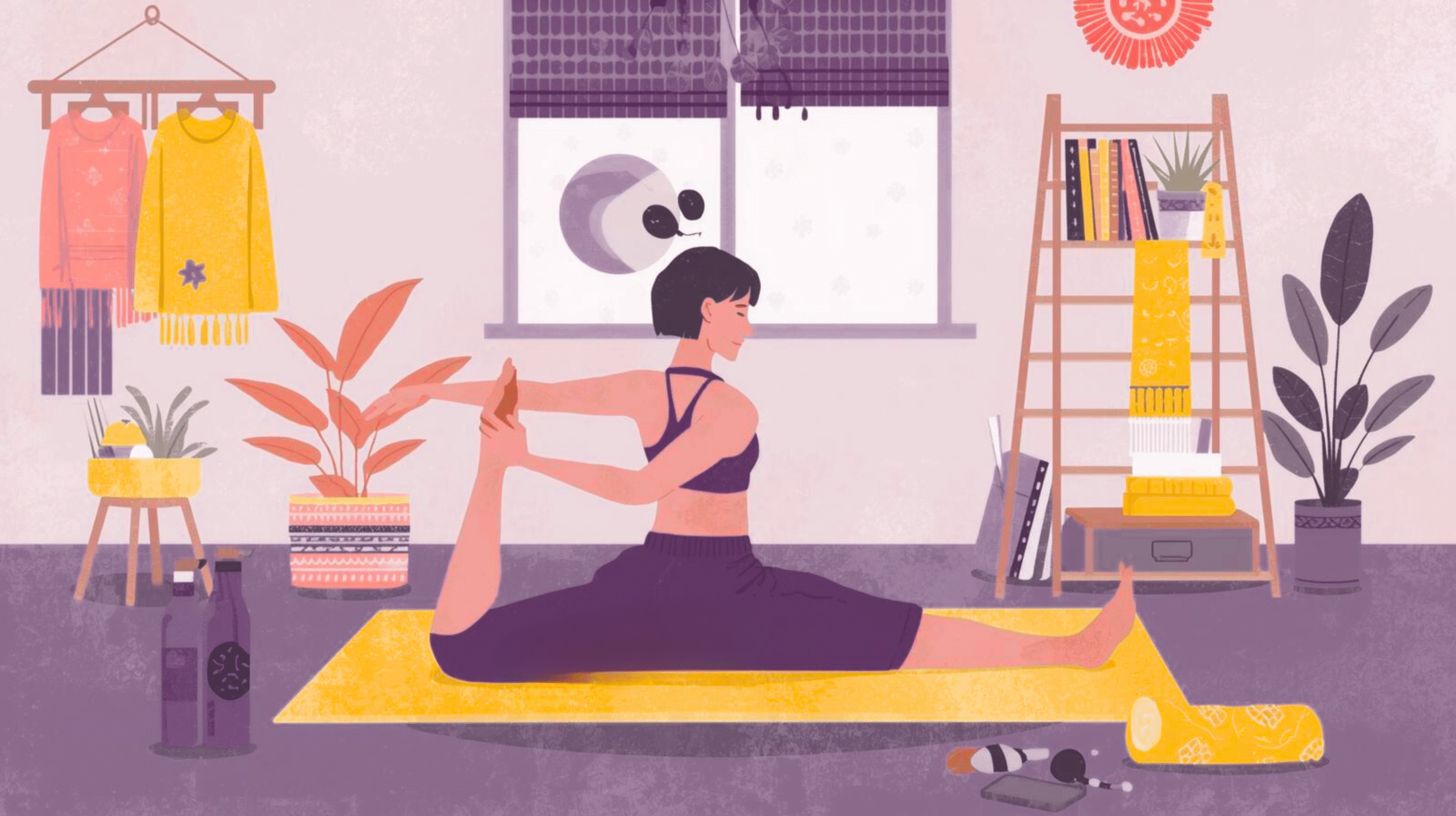Back pain is one of the most common health issues worldwide, affecting millions of people of all ages and lifestyles. From office workers who spend long hours sitting at a desk to homemakers constantly bending and lifting, and even active individuals who strain their backs during workouts, nearly everyone experiences some form of discomfort in the lower back at some point. For beginners, the idea of exercising to relieve back pain can feel intimidating. Many fear making the pain worse or performing the wrong movements. However, when done correctly, gentle, low-impact exercises can be a safe and effective way to relieve discomfort, improve mobility, and strengthen the muscles that support the spine.
The human back is a complex structure made up of bones, muscles, ligaments, and intervertebral discs. These components work together to provide support, flexibility, and movement. But prolonged sitting, poor posture, lack of physical activity, or sudden strain can disrupt this balance, leading to stiffness, tension, and pain. Instead of relying solely on medications or passive treatments, incorporating beginner-friendly exercises into your daily routine helps activate the muscles, improve circulation, and promote natural healing.
One of the greatest advantages of beginner back exercises is that they are accessible. You don’t need a gym membership or fancy equipment to get started. Many stretches and movements can be performed at home using just a mat or a sturdy chair. These exercises are specifically designed to target the lower back, core, and surrounding muscles without putting unnecessary strain on the body. By focusing on gentle movements, beginners can gradually improve flexibility, strength, and posture while minimizing the risk of injury.
Another important aspect of beginner back exercises is that they teach awareness of the body. Often, back pain is worsened by unconscious habits like slouching, improper lifting, or uneven weight distribution. Through mindful stretching and strengthening routines, beginners learn how to engage the right muscles and maintain proper alignment during daily activities. This not only alleviates existing pain but also helps prevent future discomfort.
It is crucial to emphasize that these exercises are intended for mild to moderate back pain. Severe or chronic back conditions should be evaluated by a healthcare professional before starting any new routine. Beginners should also pay attention to their body’s signals—gentle discomfort is normal, but sharp or worsening pain should be addressed immediately. With proper guidance and consistency, even short daily sessions of stretching, mobility, and core-strengthening exercises can make a noticeable difference in comfort and movement over time.
In this article, we will explore a comprehensive range of beginner back pain exercises, including stretches, strengthening moves, core routines, and mobility exercises. Each exercise is explained with clear instructions and tips to ensure safe practice at home. Additionally, we will discuss daily routines, common mistakes to avoid, and lifestyle habits that complement your exercises for long-lasting relief. By the end, beginners will have a practical toolkit to start managing back pain safely, improve posture, and regain confidence in movement without feeling overwhelmed.
Whether you’re new to exercising or have struggled with back discomfort for years, these beginner-friendly routines are designed to help you move with ease, support your spine, and reduce tension naturally. With dedication and mindful practice, relief from back pain is achievable, and the foundation for a stronger, healthier back can be built from the comfort of your own home.

Types of Beginner Back Pain Exercises
Before diving into specific exercises, it’s important to understand the types of movements that are most beneficial for beginners. Not every stretch or exercise is suitable for all types of back pain, so it’s helpful to categorize them:
1. Stretching Exercises
Stretching exercises focus on increasing flexibility and relieving tension in tight muscles. Common areas include the lower back, hamstrings, glutes, and hip flexors. Gentle stretches improve blood flow to the muscles, reduce stiffness, and prepare your back for more strengthening exercises.
2. Strengthening Exercises
Strengthening exercises target the core muscles that support the spine, including the abdominal, oblique, and lower back muscles. A strong core stabilizes your back, reduces strain on the spine, and helps prevent future injuries.
3. Mobility Exercises
Mobility exercises help maintain or restore the natural range of motion in your spine and hips. These movements are particularly useful for individuals who spend long hours sitting or have limited flexibility.
4. Low-Impact Aerobic Exercises
Low-impact exercises like walking, swimming, or cycling improve overall circulation, aid in weight management, and reduce pressure on the spine while supporting muscle endurance.
Beginner-Friendly Back Pain Stretches
Cat-Cow Stretch
- How to do it: Start on your hands and knees, wrists aligned under shoulders, knees under hips. Inhale, arch your back downward (cow pose), lifting your head and tailbone. Exhale, round your spine upward (cat pose), tucking your chin and tailbone.
- Benefits: Gently mobilizes the spine, stretches the back and core, and relieves tension.
Child’s Pose
- How to do it: Kneel on the floor, sit back on your heels, and stretch your arms forward, lowering your torso toward the mat.
- Benefits: Provides a gentle stretch for the lower back and hips while promoting relaxation.
Knee-to-Chest Stretch
- How to do it: Lie on your back, bend one knee, and bring it toward your chest, holding it with both hands. Repeat with the other leg.
- Benefits: Relieves lower back tension and stretches the glutes and hamstrings.
Seated Spinal Twist
- How to do it: Sit on the floor with legs extended. Cross your right leg over your left and twist your torso to the right, placing your left elbow on the outside of your right knee. Repeat on the other side.
- Benefits: Improves spinal mobility and releases tension in the mid and lower back.
Hamstring Stretch
- How to do it: Sit on the floor with one leg extended and the other bent. Reach toward the toes of the extended leg, keeping your back straight.
- Benefits: Reduces hamstring tightness, which can contribute to lower back pain.
Beginner Back Strengthening Exercises
Pelvic Tilts
- How to do it: Lie on your back with knees bent, feet flat on the floor. Tighten your abdominal muscles and gently flatten your lower back against the floor. Release and repeat.
- Benefits: Strengthens the core, improves posture, and stabilizes the spine.
Bridges
- How to do it: Lie on your back with knees bent, feet hip-width apart. Lift your hips toward the ceiling, squeezing your glutes. Lower slowly.
- Benefits: Strengthens glutes, hamstrings, and lower back muscles.
Bird Dog
- How to do it: Start on hands and knees. Extend your right arm forward and left leg back, keeping your spine neutral. Hold, then switch sides.
- Benefits: Enhances core stability and coordination, reduces strain on the lower back.
Wall Sits
- How to do it: Stand with your back against a wall, slide down into a sitting position, knees at a 90-degree angle. Hold for 10–30 seconds.
- Benefits: Strengthens core and leg muscles while providing gentle support to the lower back.
Daily Routines and Lifestyle Tips
- Consistency: Perform stretches and exercises daily for 10–20 minutes.
- Ergonomics: Adjust your chair, screen height, and desk setup to maintain proper posture.
- Breaks: Take short breaks every 30–60 minutes to stand, stretch, and move.
- Mindful Movement: Engage your core when lifting or bending.
- Hydration and Nutrition: Proper hydration and a balanced diet help muscle recovery and spinal health.
Common Mistakes to Avoid
- Overstretching: Pushing too far can aggravate pain.
- Ignoring Pain Signals: Sharp pain is a warning to stop.
- Skipping Warm-Up: Always perform gentle movements before stretching.
- Poor Form: Incorrect posture during exercises can worsen back pain.
- Neglecting Core Strength: Stretching alone isn’t enough; strengthening exercises are essential.
Conclusion
Beginner back pain exercises are a safe and effective way to manage discomfort, improve flexibility, and strengthen the muscles that support your spine. By incorporating a mix of stretching, strengthening, and mobility routines, you can address both the causes and symptoms of lower back pain. Consistency is key. Even short daily sessions can lead to noticeable improvements in posture, muscle support, and overall comfort.
In addition to exercises, mindful lifestyle choices like proper ergonomics, regular movement breaks, and healthy habits complement these routines for long-term relief. Remember, back pain often develops due to a combination of factors such as prolonged sitting, weak core muscles, poor posture, and muscle imbalances. By addressing these issues gradually, beginners can reduce the likelihood of future discomfort.
Importantly, these exercises are not a replacement for medical advice. People with chronic, severe, or sudden back pain should consult a healthcare professional before starting a new routine. By listening to your body, following proper guidance, and gradually building strength, even beginners can achieve a stronger, more flexible, and pain-free back. With time and dedication, these simple at-home exercises can help you regain confidence, move freely, and enjoy daily activities without the constant burden of back discomfort.
Looking for more tips? Don’t miss these related guides.
- https://betterhood.in/learn/muscle-pain-causes/
- https://betterhood.in/learn/effective-home-remedies-for-body-pain-relief-naturall/
Frequently Asked Questions:
1. How often should I do beginner back exercises?
Aim for 5–6 days per week, 10–20 minutes per session. Short, consistent practice is more effective than occasional long sessions.
2. Can I do these exercises if I have chronic back pain?
Mild to moderate pain is generally safe, but consult a healthcare professional for chronic or severe conditions.
3. Do I need equipment for these exercises?
Most exercises can be done at home using just a mat. A chair or small resistance band can be used optionally.
4. When should I stop an exercise?
Stop if you feel sharp, shooting pain or numbness. Mild stretching discomfort is normal, but pain indicates an issue.
5. Can beginners still benefit if they are older adults?
Yes. These exercises are low-impact and safe for older adults when done with proper form and guidance.
References
- Mayo Clinic. (2021, May 15). Non-invasive treatments for back pain. Retrieved September 22, 2025, from https://www.mayoclinic.org/diseases-conditions/back-pain/diagnosis-treatment/drc-20369906
- Medical News Today. How to strengthen the lower back. Retrieved April 14, 2025, from https://www.medicalnewstoday.com/articles/323204
- Dr. Swagatesh Bastia.10 Exercises to Ease Back Pain and Regain Comfort. Retrieved September 22, 2025, from https://alleviatepainclinic.com/blog/back-pain-exercises/



















